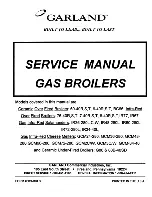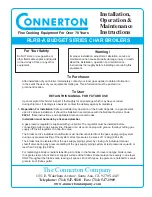
24
X Start-up and Checkout
NOTE
SAFE LIGHTING AND OTHER PERFORMANCE CRITERIA WERE MET WITH THE GAS MANIFOLD AND
CONTROL ASSEMBLY PROVIDED ON THE BOILER WHEN THE BOILER UNDERWENT THE TESTS
SPECIFIED IN Z21.13.
Use the following procedure for initial start-up of the boiler:
1) Make sure that the boiler and system are filled with water.
2) Check all gas piping for leaks and purge piping sections that are filled with air. See of the
National Fuel Gas Code
for
additional information on testing and purging gas lines.
3) Verify that vent system is complete and free of obstructions before attempting to fire boiler.
4) Inspect all wiring for loose or uninsulated connections.
5) Make sure the main burners are seated properly in the rear of burner tray and on orifices.
6) Adjust thermostat to the highest setting.
7) Start the boiler using the operating instructions on page 25. The red LED display on boiler control should illuminate as
soon as power is applied to the boiler, but it will take approximetly 1 minute from the time power is applied to the boiler,
and the thermostat is closed, until the first trial for ignition. For additional information on boiler operation, see Section
XI.
8) Upon initial start-up, the gas train will be filled with air. Even if the gas line has been completely purged of air, it
may take several tries for ignition before a flame is established. Once a flame has been established for the first time,
subsequent calls for burner operation should result in a flame on the first try.
9) Inspect the pilot burner flame. The pilot burner produces three flames. The center one should be a steady medium blue
flame covering around 3/8” to 1/2” of spark electrode/flame rod. (Figure 10.1)
10) Make sure vent damper is in open position when main burners are firing.
11) Inspect the main burner flames visible through the observation port in burner access panel. The flame should be stable
and mostly blue (see Figure 10.2). No yellow tipping should be present; however, intermittent flecks of yellow and
orange in the flame are normal.
12) Check entire gas train for leaks using soap and water or other approved leak detection method while boiler is firing. Fix
any leaks found immediately.
WARNING
• GAS LEAKS MAY RESULT IN FIRE OR EXPLOSION.
• NEVER USE A FLAME TO CHECK FOR GAS LEAKS.
• MAKE SURE THAT THE AREA AROUND THE BOILER IS CLEAR AND FREE FROM
COMBUSTIBLE MATERIALS, GASOLINE AND OTHER FLAMMABLE VAPORS AND
LIQUIDS.
• WATER LEAKS MAY CAUSE EXTENSIVE PROPERTY DAMAGE.
WARNING
DO NOT LEAVE THE BOILER IN SERVICE IF IT FAILS ANY OF THE FOLLOWING
START-UP CHECKS. DOING SO MAY RESULT IN FIRE, EXPLOSION, OR CARBON
MONOXOIDE (CO) POISONING.
Summary of Contents for AWR038
Page 2: ......
Page 23: ...21 FIGURE 9 0 LINE VOLTAGE FIELD CONNECTIONS FIGURE 9 1 LOW VOLTAGE FIELD CONNECTIONS...
Page 24: ...22 FIGURE 9 2 INTERNAL CONNECTIONS DIAGRAM...
Page 25: ...23 FIGURE 9 3 LADDER DIAGRAM...
Page 43: ...41 Notes...
Page 45: ...43...
Page 47: ...45...
















































